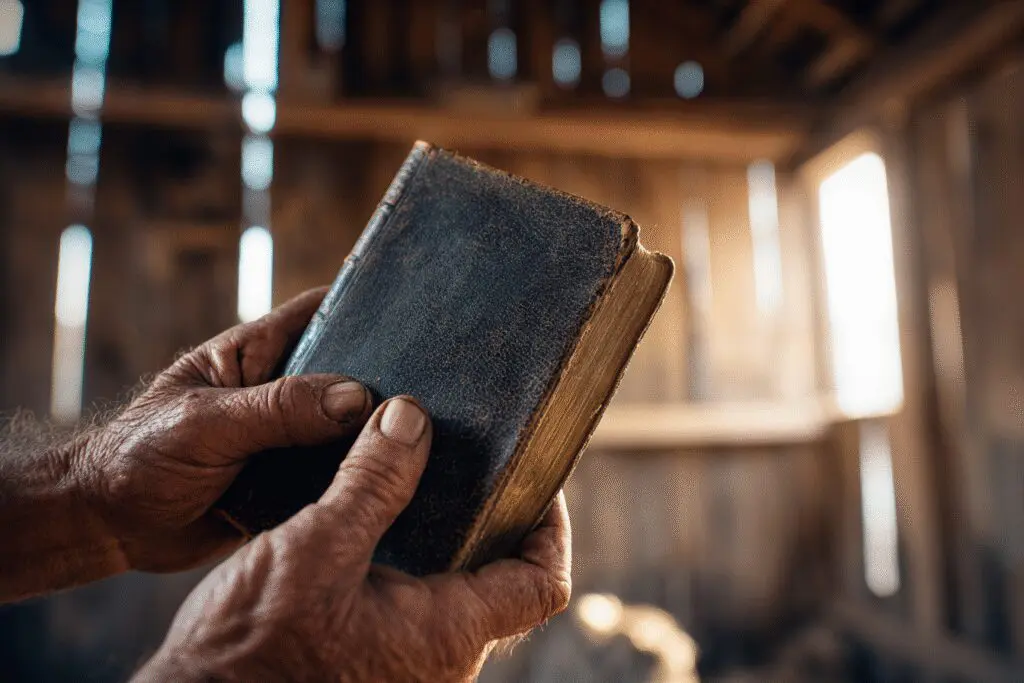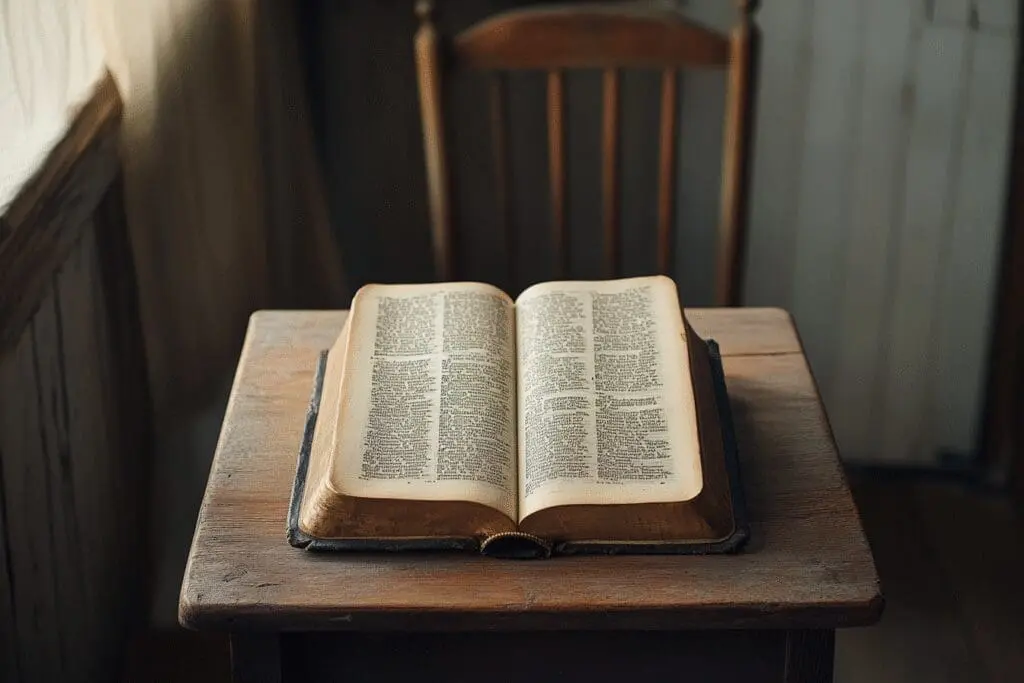I was driving through Lancaster County, Pennsylvania, a few years back, just watching the world go by at a slower pace. I saw a farmer out on a plow pulled by two massive Belgian draft horses, and it hit me just how different his world was from mine.
I’ve always been fascinated by the Amish—not in a touristy, superficial way, but with a genuine curiosity about how they maintain a life so intentionally separate from the rest of us. It led me down a rabbit hole of questions. How do they run a business without a website? How do they build a barn in a day? And one question that really stuck with me: What Bible do the Amish use?
It seems like a simple question, but I suspected the answer was wrapped up in layers of tradition, language, and a worldview I could only begin to understand. It’s not just about which book they pull off the shelf; it’s about why that specific book holds so much authority in a world that’s constantly updating everything. This isn’t just an academic question for me; it feels like a key to understanding their steadfastness.
More in Bible Category
Key Takeaways
Before we dive deep, here’s the short of it for those of you who just need the quick answer:
- The German Bible: The most traditional and widely used Bible among Amish communities is the German Martin Luther translation, often called the Lutherbibel. This connects to their German heritage and is used in their church services.
- The English Bible: For personal study, reading at home, and in more progressive communities, the Amish use the King James Version (KJV). Its formal, traditional language aligns with their values of reverence and respect for scripture.
- No Modern Versions: You won’t find modern translations like the NIV, ESV, or The Message in an Amish home. They are seen as too interpretive and straying from the original text’s authority.
- It’s About More Than Words: Their choice is deeply tied to the principles of separation from the modern world (demut or humility) and preserving their cultural and spiritual heritage.
So, Which Bible Is Actually on Their Shelf?
When I first started looking into this, I imagined there was one single, official “Amish Bible.” It turns out, it’s a little more nuanced than that and often depends on the context of its use—whether it’s for church or for reading by the fire at home.
Is It Always a German Bible?
For the most part, yes, especially when it comes to the heart of their community: the church service. The go-to scripture for worship is the High German translation by Martin Luther. The first time I heard this, I was a bit surprised. I associated Martin Luther with the Protestant Reformation, but I didn’t immediately connect him to the Amish.
But it makes perfect sense. The Anabaptist movement, from which the Amish emerged, began in the 16th century, right in the thick of the German-speaking Reformation. Luther’s translation was revolutionary, bringing the Bible into the common language of the people. For the Amish, using his German Bible isn’t just a religious choice; it’s a direct link to their spiritual ancestors. It’s a way of holding onto the very words that defined their faith from its fiery beginnings.
I tried reading a few passages from a digital version of the Luther Bible online, and let me tell you, it’s not easy for a modern English speaker. The language is dense and formal. It made me realize that for the Amish, reading the Bible isn’t about casual consumption. It’s an act of deep focus and reverence, connecting them to centuries of believers who read those exact same phrases.
What About English-Speaking Amish?
This is where the King James Version (KJV) comes in. While High German is the language of their church services, it’s not the language they speak at home. Most Amish speak a German dialect called Pennsylvania Dutch (or Pennsylvania German). For everyday life and business with the “English” (that’s their term for the non-Amish), they speak English.
So, when it comes to personal devotion, family readings, or when a German Bible isn’t practical, the King James Version is their trusted source. I used to wonder why they’d pick the KJV, with all its “thees” and “thous.” Why not something a little more straightforward?
Then it clicked. The KJV’s formal, almost poetic language prevents the scripture from becoming too casual. It maintains a sense of holiness and separation from everyday chatter. In a way, the old-fashioned language of the KJV serves the same purpose as the German Luther Bible: it sets the Word of God apart. It signals that you are stepping onto holy ground, and it’s a stark contrast to the easy-come, easy-go nature of modern communication. It’s a deliberate choice to use a text that requires you to slow down and think.
But Why These Specific Bibles? Is It Just About Tradition?
It’s easy to say “the Amish are traditional” and leave it at that. But I’m more interested in the “why.” It’s not just a stubborn refusal to change. Their choice of scripture is one of the most powerful expressions of their core beliefs, woven directly into their language and their view of the world.
Does It Have to Do with Their Language?
Absolutely. Language is a huge part of how the Amish maintain their separation and identity. For many Old Order Amish communities, life is trilingual, and each language has a specific purpose.
- Pennsylvania Dutch: This is the language of the home and the community. It’s a German dialect that has evolved over centuries in America. It’s the language they use to talk with family, joke with neighbors, and conduct daily life. It’s the language of their heart.
- High German: This is what I think of as their “sacred language.” It’s the language of the Martin Luther Bible and their hymnal, the Ausbund. They don’t speak it conversationally; its use is reserved almost exclusively for worship and reading scripture. Using this formal, ancestral German reinforces the solemnity of their faith.
- English: This is their functional language for interacting with the outside world. They learn it in school and use it for business, reading non-religious books, and talking to people like me.
This linguistic separation is a powerful tool. By keeping their worship in a language distinct from their daily and worldly interactions, they build a wall around their faith, protecting it from outside influences.
Are Modern Translations a No-Go?
You will almost certainly never find a New International Version (NIV) or a New Living Translation (NLT) in an Amish home. To an outsider, this might seem rigid. Modern translations are designed for readability and clarity. Wouldn’t that be a good thing?
From their perspective, however, “readability” can come at a cost. The Amish are wary of anything that feels like it’s been changed or simplified to suit modern tastes. They believe that newer translations take too many liberties, interpreting the text rather than translating it directly. There’s a deep-seated belief that the Luther and King James versions are more faithful to the original Hebrew and Greek manuscripts.
This skepticism is rooted in a core Amish value: resisting the constant tide of change that defines the modern world. For them, faith is a rock, something permanent and unchanging. Introducing a new Bible translation would be like chipping away at that rock. It opens the door to questioning and reinterpretation, which could eventually erode the foundations of their community. Their commitment to these older texts is a testament to their desire for a faith that is stable and absolute. For a deeper academic look into Anabaptist beliefs and scripture, the Young Center for Anabaptist and Pietist Studies at Elizabethtown College is an incredible resource.
How Does the Bible Actually Shape Their Day-to-Day Life?
For the Amish, the Bible isn’t a book they just read on Sunday. It’s the blueprint for their entire existence—from their family structure to their rejection of technology. It’s not just a source of comfort; it’s a source of instructions for living.
Is It Read Differently Than in Other Churches?
One of the most significant differences lies in the application. While many modern Christians focus on theological study and intellectual understanding, the Amish prioritize a literal, practical application of the Bible’s teachings. It’s less about abstract doctrine and more about tangible discipleship.
Their church services are a perfect example. They are held in community members’ homes, not in ornate church buildings. The sermons, which can last for over an hour, are often delivered without notes. The preachers speak from the heart, drawing on familiar passages and applying them directly to the challenges and realities of community life.
This emphasis is on living out the scriptures. Passages that command humility, non-resistance, and separation from worldly things are not seen as metaphors. They are direct commands that inform everything from their simple style of dress to their refusal to participate in the military. It’s a faith lived, not just professed.
Does the Bible Influence Their Rules for Living?
The Bible is the ultimate authority, but the way it’s applied is guided by the Ordnung. The Ordnung is an unwritten set of rules and understandings that governs the community. It’s not a separate holy book; it’s the community’s collective interpretation of how to apply biblical principles to their specific time and place.
The Ordnung covers everything, from the style of hats women wear to the type of farming equipment that is permissible. It’s often what outsiders find most strange about the Amish. But if you trace these rules back, they are almost always connected to a biblical principle.
- Plain Dress: This comes from biblical commands to dress modestly and not conform to the patterns of the world (1 Timothy 2:9, Romans 12:2). It’s a visual rejection of vanity and pride.
- Horse and Buggy: The refusal to own cars is a way to keep their communities geographically close and prevent the “worldliness” that comes with easy travel. It promotes a slower pace of life and reliance on one’s neighbors.
- No Public Grid Electricity: Avoiding the public power grid is a major form of separation from the world. It limits the kinds of technologies and media that can enter the home, protecting the family unit from outside influences.
These rules, guided by the Ordnung, are all attempts to faithfully live out the Bible’s commands for a separated, holy life. It’s a radical commitment that I can’t help but respect, even if I don’t fully understand it.
I’ve Heard About Something Called the ‘Ausbund.’ Is That Their Bible?
While researching this topic, I kept stumbling across references to the Ausbund. For a while, I was confused. Was this another version of the Bible they used? A commentary? It turns out, it’s something entirely different but just as important to their faith.
What Exactly Is the Ausbund?
The Ausbund is not a Bible. It’s a hymnal. But calling it just a hymnal feels like an understatement. It’s the oldest Anabaptist hymnal still in continuous use, with its origins stretching back to the 1500s. The core of the book was written by a group of Anabaptists imprisoned in a castle dungeon in Passau, Germany, between 1535 and 1540.
It contains no musical notation. The melodies are passed down orally from generation to generation. The songs are long, slow, and somber. They are not songs of cheerful praise but are instead powerful, haunting accounts of persecution, suffering, and steadfast faith. The hymns tell the stories of martyrs who died for their beliefs, reminding each new generation of the cost of their faith.
To sit in an Amish church service is to hear a congregation connect directly with the suffering of their 16th-century ancestors. It’s a powerful expression of their collective memory and identity.
So How Do the Bible and Ausbund Work Together?
If the Martin Luther Bible is the foundation of their doctrine and theology, the Ausbund is the foundation of their emotional and historical identity. The Bible tells them what to believe, and the Ausbund reminds them why that belief is worth preserving, even in the face of hardship.
The two books work hand in hand. The Bible provides the teachings of Jesus and the Apostles, outlining the principles of peace, humility, and separation. The Ausbund provides the real-world examples of their ancestors who lived and died for those very principles. One is the instruction manual; the other is the collection of powerful, tragic, and inspiring user stories. Together, they create a faith that is both theologically robust and deeply personal.
A Faith Preserved in Print
So, what Bible do the Amish use? They use the German Luther Bible for its sacred, ancestral authority and the English King James Version for its formal, reverent tone.
But the real answer is so much deeper. Their choice of scripture is a conscious act of preservation. In a world that prizes novelty and constant updates, the Amish have chosen to anchor themselves to texts that are steadfast and unchanging. Their Bibles are not just books; they are artifacts of a faith that has weathered centuries of change. They are a declaration that some things are too important to be revised, updated, or made more convenient. And in a way, I think that’s a lesson the rest of us could probably stand to think about.
Frequently Asked Questions – What Bible Do the Amish Use

How do the Amish interpret and read the Bible within their community?
The Amish read the Bible aloud in church services with slow, deliberate phrasing, emphasizing community interpretation and oral tradition. They memorize many verses and aim to live out Biblical teachings daily, guided by their elders’ understanding.
What is the Ausbund and why is it important to the Amish?
The Ausbund is the Amish songbook, crafted in 1564, containing hymns written by Anabaptist martyrs. It is vital to Amish worship because it connects them with their history, faith, and the suffering of their ancestors.
What role does the King James Version play in Amish life in English?
The King James Version (KJV) is used by some Amish in English for specific purposes like talking with outsiders, in education, or personal study, but it is secondary to their primary German Bible and used only when necessary.
Why do the Amish prefer reading the Bible in German rather than English?
The Amish prefer reading the Bible in German because it links them to their past, their faith, and their history of hardship as Anabaptists. German, especially in its High German form, is considered a sacred and formal language appropriate for worship.
What Bible do the Amish mainly use in their religious practices?
The Amish mainly use the German Martin Luther Bible, which is an old and revered German translation of the Bible that originated in the 16th century.




